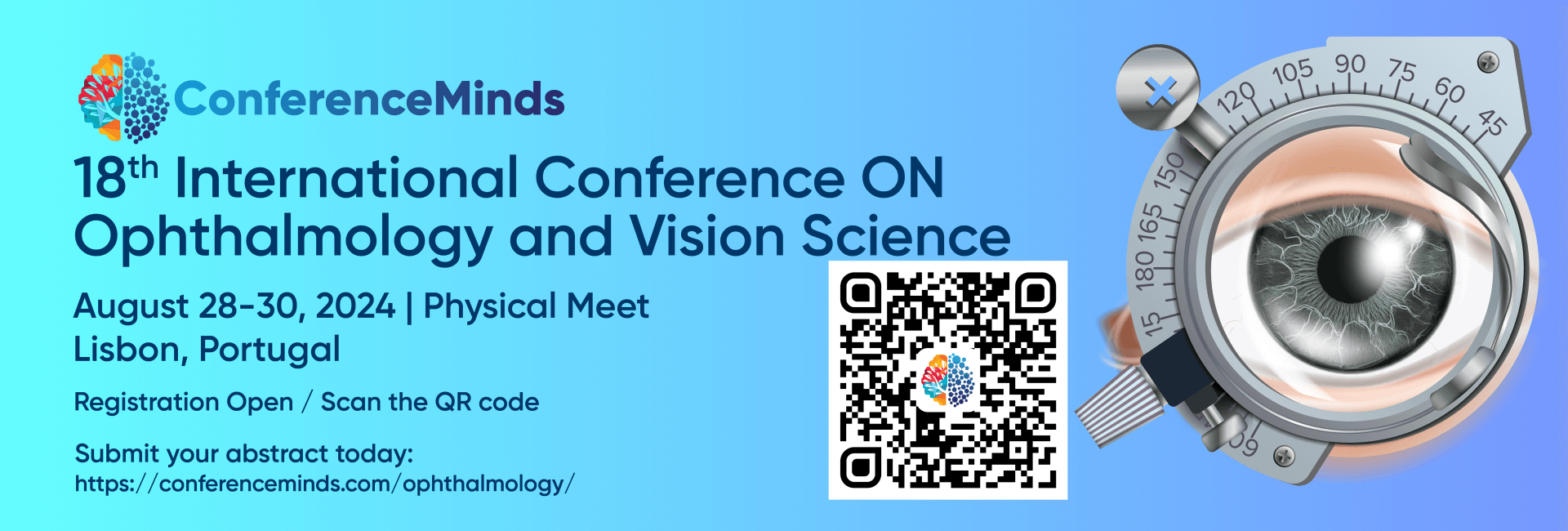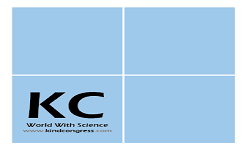
18th International Conference
ON
Ophthalmology and Vision Science
Event Date
August 28-30, 2024
Venue
Lisbon, Portugal
– Previous Conference Performers / Professionals From Around The Globe –

Aikaterini Ziaka
- Physio4you, Greece

AMR Hawal
- Professor, Prime Healthcare Group UAE

Antonio Steardo
- University of Salerno, Italy

Ashraf Lotfy Fayed
- ENT Military Hospital, Egypt

Aspazija Sofijanova
- Director of Pediatric Clinic, Macedonia

Brandon P. Lucke-Wold
- University of Florida, Florida

Brankica Vasiljevic
- NMC Royal Hospital, UAE

Bruce Ogden
- Director of Operations US Foods USA

Cornelia Beyer
- University of Hull, UK

Grazzia Rey
- University of the Republic, Uruguay

Heather Carmello
- University of Rochester, USA

Howard Weber
- Penn State Hershey Childrens Hospital, USA

Irene Hamrick
- University of Cincinnati, USA

José De Jesús Curiel Valdés
- Clínical Patology, Mexico

Lloyd L. Tran
- Biomed Industries, USA

Luca Roncati
- University Hospital of Modena, Italy

Maria Braoudaki
- University of Hertfordshire , United Kingdom

Marina F Gubkina
- National Research Medical University, Russia

Peter Krcho
- Pavol Jozef safarik University, Slovakia

Pinghong Zhou
- Fudan University, China

Raffaele Pilla
- University of Salerno, Italy

Ruut Veenhoven
- Seres Therapeutics, United States

Said Moustafa M. El-deib
- Yas Clinic Khalifa City UAE

Sajidxa Marino
- Central University of Venezuela, Venezuela

Sajidxa Marino
- Central University of Venezuela, Venezuela

Sam Vaknin
- Southern Federal University, Russia

Sandra Vélez Candelario
- Catholic University of Puerto Rico, USA

Simon Treissman
- Royal Inland Hospital, Canada

Taylor Bean
- Salmon Arm, Canada

Thiago Hoesker
- Neuro surgeon , Brazil

Tracy Roake
- Danat Al Emarat Hospital, UAE

Vladimir Zajac
- Cancer Research Institute, Slovakia

William J Rowe
- Specialist in Medicine, USA

Yacob Mathai
- Marma Health Centre, India

Yu You Liu
- National Chung Hsing University, Taiwan
Media Partners/Collaborator
A huge thanks to all our amazing partners. We couldn’t have a conference without you!










Sponsors/Exhibitors
A huge thanks to all our amazing partners. We couldn’t have a conference without you!


OPHTHALMOLOGY CONFERENCE 2024
ConferenceMinds would like to invite you to the Physical event “18th International Conference on Ophthalmology and Vision Science 2024” which is going to be held on August 28-30, 2024 in Lisbon, Portugal
Ophthalmology Conference 2024 and we welcome the Scientists, Doctors, Academician, Researchers, Students, and Business Entrepreneurs related to the broad areas of ophthalmology, Medical, and Health care, Ophthalmology organizations are most likely to attend Ophthalmologists 2023 welcome the Scientists, Doctors, Academician, Researchers, Students, Business and utilize the scope of extending their skills, and their work on basic and significant applications. This Ophthalmology Conference 2024 will be useful to participants from both the Industry and Academia working in all the domains of Health care sectors, and all other target audience includes.
Ophthalmology Conference 2024 brings together a unique and international mix of large and medium pharmaceutical, biotech, and diagnostic companies, leading universities, and clinical research institutions making the conference a perfect platform to share experience, foster collaborations across industry and academia, and evaluate emerging technologies across the globe. Ophthalmology Congress 2024 maximizes the opportunity to interact with and learn from your peers from across the country and across the globe it held with discussions on Cornea and External Eye Disease, Retina and Retinal Disorders, Neuro–Ophthalmology, Glaucoma, Visual Field Loss, Ocular Microbiology and Immunology, Novel Approaches to Ophthalmology therapeutics and many more.
Target Audience
- Eye surgeons
- Ophthalmologists
- Optometrists
- Clinical researchers & Scientists
- Physicians
- Eye care specialists
- Radiologists
- Medical Imaging Specialists
- Professors
- Business professionals
- Directors, Presidents, CEO
- Ophthalmology equipment companies
- Medical Practitioners
- Medical & Health care Organizations & Associations
- Eye care product Manufacturers
- Public Health Professionals
- Diagnostic Instruments in Optometry
Sessions and Tracks
- Clinical Ophthalmology
- Retina and Retinal Detachment
- Optometry & Vision Science
- Glaucoma
- Latest Research in Ophthalmology and Vision Improvement
- Cornea Disorders and Treatments
- Macular Degeneration
- Ocular Oncology
- Paediatric & Strabismus
- Neuro Ophthalmology
- Lens and Cataracts
- Diabetic Retinopathy
- Medicine in Ophthalmology
- Astigmatism
- Vision Rehabilitation
- Ophthalmology Disorders
- Eye Transplant
- Oculoplastics and Orbit Surgery
- Ophthalmic Drug Delivery
- Orbital Disorders
- Ophthalmology Practice
- Cataract and Refractive Surgery
- Keratoprosthesis
- Veterinary Vision
- Latest and Innovative Eye Research
Session and Tracks
- Refractive Surgery and Laser Vision Correction: Explore the frontiers of refractive surgery and laser vision correction in this session. Delve into the latest advancements in technologies such as LASIK, PRK, and SMILE, analyzing their efficacy, safety profiles, and patient satisfaction. Experts will discuss evolving techniques, personalized approaches, and the future landscape of vision correction.
- Retinal Diseases and Imaging Techniques: Uncover the complexities of retinal diseases and the state-of-the-art imaging techniques employed for early detection and monitoring. Leading researchers and clinicians will share insights into groundbreaking advancements in managing conditions like age-related macular degeneration, diabetic retinopathy, and retinal vascular disorders.
- Corneal Disorders and Transplantation: A comprehensive examination of corneal disorders, transplantation techniques, and emerging therapies awaits attendees. Explore the latest innovations in keratoplasty, lamellar procedures, and therapeutic interventions for corneal diseases. Learn from experts about the transformative impact of these advancements on patient outcomes.
- Pediatric Ophthalmology and Strabismus: This track focuses on pediatric eye care, covering vision screenings, common childhood eye conditions, and the latest interventions for strabismus. Pediatric ophthalmologists will share insights into managing unique challenges in young patients, emphasizing both medical and surgical approaches.
- Glaucoma Diagnosis and Management: Dive deep into the intricate world of glaucoma, exploring diagnostic modalities, medical management strategies, and surgical interventions. This session brings together experts to discuss the latest research on intraocular pressure control, neuroprotective approaches, and advancements in understanding the pathophysiology of glaucoma.
- Ophthalmic Plastic Surgery and Aesthetics: Discover the intersection of ophthalmic surgery and aesthetics. Renowned surgeons will present the latest techniques in eyelid surgery, orbital procedures, and aesthetic interventions around the eyes. Learn about the evolving landscape of ophthalmic plastic surgery and its impact on both function and appearance.
- Neuro-Ophthalmology and Visual Sciences: Understand the intricate relationship between the eyes and the nervous system in this specialized track. Experts in neuro-ophthalmology will discuss the diagnosis and management of complex cases, shedding light on the impact of neurological conditions on visual function.
- Ocular Oncology and Pathology: Journey into the realm of ocular tumors, their pathology, and innovative treatment approaches. Leading pathologists and oncologists will discuss advancements in the diagnosis and management of retinoblastoma, ocular melanoma, and other ocular malignancies.
- Cataract Surgery and Intraocular Lenses: Join experts in exploring the latest trends in cataract surgery, intraocular lens technologies, and preoperative assessment strategies. This session will cover surgical techniques, lens implantation advancements, and outcomes, offering valuable insights for ophthalmic surgeons.
- Ophthalmic Research and Innovations: Immerse yourself in the cutting-edge research shaping the future of ophthalmology. From novel treatment modalities to groundbreaking technologies, this session will showcase the latest innovations and their potential impact on advancing patient care and outcomes.
- Low Vision Rehabilitation and Assistive Technology: Addressing the needs of individuals with low vision, this track explores rehabilitation strategies and the integration of assistive technologies. Learn about the latest advancements in enhancing the quality of life for those with visual impairments through innovative interventions.
- Anterior Segment Disorders and Surgical Techniques: This session delves into disorders affecting the anterior segment of the eye, including corneal and lens-related conditions. Experts will discuss surgical interventions such as anterior segment reconstruction and advancements in phacoemulsification.
- Ophthalmic Nursing and Patient Care: Recognizing the crucial role of nurses in eye care, this track focuses on best practices in ophthalmic nursing. From preoperative and postoperative care to patient education, nurses will share insights into their evolving roles in optimizing patient outcomes.
- Ocular Pharmacology and Therapeutics: Explore the pharmacological management of various eye conditions in this session. Experts will discuss the latest developments in ocular pharmacology, including emerging therapies and innovative drug delivery systems for improved patient outcomes.
- Global Eye Health and Public Health Initiatives: Gain insights into global initiatives aimed at improving eye health on a broad scale. Experts will discuss challenges, successes, and collaborative efforts in addressing eye health disparities worldwide through public health interventions.
- Uveitis and Inflammatory Eye Diseases: Delve into the complexities of uveitis and inflammatory eye diseases. Experts will discuss diagnostic approaches, treatment modalities, and the latest research on immunomodulatory therapies, offering valuable perspectives on managing these challenging conditions.
- Optical Coherence Tomography (OCT) Advances: Stay updated on the latest advancements in optical coherence tomography (OCT) technology. This session will explore the evolving landscape of OCT applications in diagnostics and monitoring treatment responses, providing valuable insights for ophthalmic professionals.
- Emerging Technologies in Ophthalmic Surgery: This track showcases the integration of emerging technologies in ophthalmic surgery. From robotics to artificial intelligence and virtual reality, experts will discuss how these innovations are enhancing surgical precision and revolutionizing ophthalmic procedures.
- Ophthalmic Genetics and Genetic Counseling: Explore the genetic underpinnings of various eye conditions and the role of genetic testing in personalized eye care. This session will delve into the importance of genetic counseling, offering insights into risk assessments and tailored treatment plans.
- Teleophthalmology and Remote Patient Monitoring: Uncover the transformative potential of teleophthalmology in improving accessibility to eye care. This session will discuss remote patient monitoring, telemedicine platforms, and their impact on enhancing patient outcomes and follow-up care.
Market Analysis
The Ophthalmology Conference in 2024 is poised to be a crucial event in the healthcare sector, focusing on the latest developments, research findings, and advancements in the field of eye care. Market analysis indicates a growing demand for conferences dedicated to ophthalmology, driven by factors such as an aging population, increasing prevalence of eye diseases, and technological innovations in eye care.
This conference is expected to attract a diverse audience, including ophthalmologists, optometrists, researchers, medical professionals, and industry representatives. The market for ophthalmology conferences is expanding due to several key drivers, including the rising global burden of eye diseases such as cataracts, glaucoma, and age-related macular degeneration, as well as the growing importance of preventive eye care.
Key drivers for the growth of this market include the continuous evolution of ophthalmic surgical techniques, advancements in diagnostic technologies, and the development of novel treatments for various eye conditions. The Ophthalmology Conference serves as a crucial platform for professionals to share knowledge, discuss best practices, and stay updated on the latest trends in eye care.
Pharmaceutical companies, medical device manufacturers, and technology providers often leverage the conference to showcase their latest products, surgical equipment, and innovations in ophthalmic care. As eye health gains increasing importance in public health agendas, the market for ophthalmology conferences is expected to witness sustained growth. The conference will play a vital role in fostering collaboration, disseminating research findings, and contributing to the overall advancement of eye care practices and technologies.
